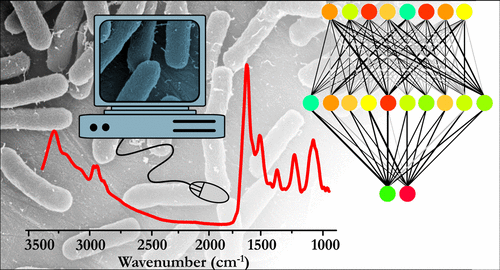当前位置:
X-MOL 学术
›
Anal. Chem.
›
论文详情
Our official English website, www.x-mol.net, welcomes your feedback! (Note: you will need to create a separate account there.)
FT-IR Hyperspectral Imaging and Artificial Neural Network Analysis for Identification of Pathogenic Bacteria
Analytical Chemistry ( IF 7.4 ) Pub Date : 2018-06-26 00:00:00 , DOI: 10.1021/acs.analchem.8b01024 Peter Lasch 1 , Maren Stämmler 1 , Miao Zhang 1 , Malgorzata Baranska 2 , Alejandra Bosch 3 , Katarzyna Majzner 1, 2
Analytical Chemistry ( IF 7.4 ) Pub Date : 2018-06-26 00:00:00 , DOI: 10.1021/acs.analchem.8b01024 Peter Lasch 1 , Maren Stämmler 1 , Miao Zhang 1 , Malgorzata Baranska 2 , Alejandra Bosch 3 , Katarzyna Majzner 1, 2
Affiliation

|
Identification of microorganisms by Fourier transform infrared (FT-IR) spectroscopy is known as a promising alternative to conventional identification techniques in clinical, food, and environmental microbiology. In this study we demonstrate the application of FT-IR hyperspectral imaging for rapid, objective, and cost-effective diagnosis of pathogenic bacteria. The proposed method involves a relatively short cultivation step under standardized conditions, transfer of the microbial material onto suitable IR windows by a replica method, FT-IR hyperspectral imaging measurements, and image segmentation by machine learning classifiers, a hierarchy of specifically optimized artificial neural networks (ANN). For cultivation, aliquots of the initial microbial cell suspension were diluted to guarantee single-colony growth on solid agar plates. After a short incubation period when microbial microcolonies achieved diameters between 50 and 300 μm, microcolony imprints were produced by using a specifically developed stamping device which allowed spatially accurate transfer of the microcolonies’ upper cell layers onto IR-transparent CaF2 windows. Dry microcolony imprints were subsequently characterized using a mid-IR microspectroscopic imaging system equipped with a focal plane array (FPA) detector. Spectral data analysis involved preprocessing, quality tests, and the application of supervised modular ANN classifiers for hyperspectral image segmentation. The resulting easily interpretable segmentation maps suggest a taxonomic resolution below the species level.
中文翻译:

FT-IR高光谱成像和人工神经网络分析鉴定致病菌
通过傅立叶变换红外(FT-IR)光谱法鉴定微生物被公认为是临床,食品和环境微生物学中常规鉴定技术的有前途的替代方法。在这项研究中,我们证明了FT-IR高光谱成像在快速,客观和具有成本效益的病原菌诊断中的应用。所提出的方法包括在标准条件下相对较短的培养步骤,通过复制方法将微生物材料转移到合适的红外窗口,FT-IR高光谱成像测量以及通过机器学习分类器(专门优化的人工神经网络的层次结构)进行图像分割(ANN)。为了培养,将初始微生物细胞悬液的等分试样稀释以确保在固体琼脂平板上单菌落生长。2个窗户。随后使用配备有焦平面阵列(FPA)检测器的中红外显微光谱成像系统对干燥的小菌落印记进行表征。光谱数据分析涉及预处理,质量测试,以及用于高光谱图像分割的监督模块化ANN分类器的应用。由此产生的易于理解的分割图表明,该分类学分辨率低于物种水平。
更新日期:2018-06-26
中文翻译:

FT-IR高光谱成像和人工神经网络分析鉴定致病菌
通过傅立叶变换红外(FT-IR)光谱法鉴定微生物被公认为是临床,食品和环境微生物学中常规鉴定技术的有前途的替代方法。在这项研究中,我们证明了FT-IR高光谱成像在快速,客观和具有成本效益的病原菌诊断中的应用。所提出的方法包括在标准条件下相对较短的培养步骤,通过复制方法将微生物材料转移到合适的红外窗口,FT-IR高光谱成像测量以及通过机器学习分类器(专门优化的人工神经网络的层次结构)进行图像分割(ANN)。为了培养,将初始微生物细胞悬液的等分试样稀释以确保在固体琼脂平板上单菌落生长。2个窗户。随后使用配备有焦平面阵列(FPA)检测器的中红外显微光谱成像系统对干燥的小菌落印记进行表征。光谱数据分析涉及预处理,质量测试,以及用于高光谱图像分割的监督模块化ANN分类器的应用。由此产生的易于理解的分割图表明,该分类学分辨率低于物种水平。



























 京公网安备 11010802027423号
京公网安备 11010802027423号